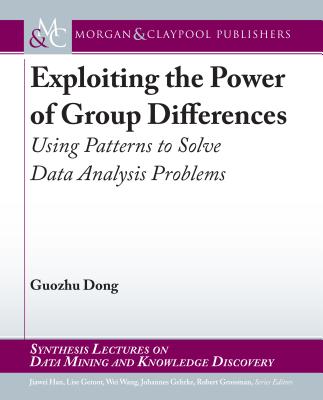Exploiting the Power of Group Differences: Using Patterns to Solve Data Analysis Problems
暫譯: 利用群體差異的力量:使用模式解決數據分析問題
Dong, Guozhu, Han, Jiawei, Getoor, Lise
- 出版商: Morgan & Claypool
- 出版日期: 2019-02-22
- 售價: $2,700
- 貴賓價: 9.5 折 $2,565
- 語言: 英文
- 頁數: 146
- 裝訂: Hardcover - also called cloth, retail trade, or trade
- ISBN: 1681735040
- ISBN-13: 9781681735047
-
相關分類:
Data Science
海外代購書籍(需單獨結帳)
商品描述
This book presents pattern-based problem-solving methods for a variety of machine learning and data analysis problems. The methods are all based on techniques that exploit the power of group differences. They make use of group differences represented using emerging patterns (aka contrast patterns), which are patterns that match significantly different numbers of instances in different data groups. A large number of applications outside of the computing discipline are also included.
Emerging patterns (EPs) are useful in many ways. EPs can be used as features, as simple classifiers, as subpopulation signatures/characterizations, and as triggering conditions for alerts. EPs can be used in gene ranking for complex diseases since they capture multi-factor interactions. The length of EPs can be used to detect anomalies, outliers, and novelties. Emerging/contrast pattern based methods for clustering analysis and outlier detection do not need distance metrics, avoiding pitfalls of the latter in exploratory analysis of high dimensional data. EP-based classifiers can achieve good accuracy even when the training datasets are tiny, making them useful for exploratory compound selection in drug design. EPs can serve as opportunities in opportunity-focused boosting and are useful for constructing powerful conditional ensembles. EP-based methods often produce interpretable models and results. In general, EPs are useful for classification, clustering, outlier detection, gene ranking for complex diseases, prediction model analysis and improvement, and so on.
EPs are useful for many tasks because they represent group differences, which have extraordinary power. Moreover, EPs represent multi-factor interactions, whose effective handling is of vital importance and is a major challenge in many disciplines.
Based on the results presented in this book, one can clearly say that patterns are useful, especially when they are linked to issues of interest.
We believe that many effective ways to exploit group differences' power still remain to be discovered. Hopefully this book will inspire readers to discover such new ways, besides showing them existing ways, to solve various challenging problems.
商品描述(中文翻譯)
這本書介紹了基於模式的問題解決方法,適用於各種機器學習和數據分析問題。這些方法都是基於利用群體差異的技術。它們利用以新興模式(即對比模式)表示的群體差異,這些模式在不同數據群體中匹配顯著不同數量的實例。書中還包括了大量計算學科以外的應用。
新興模式(EPs)在許多方面都非常有用。EPs可以用作特徵、簡單分類器、子群體簽名/特徵描述,以及警報的觸發條件。EPs可以用於複雜疾病的基因排名,因為它們捕捉多因素交互作用。EPs的長度可以用來檢測異常、離群值和新穎性。基於新興/對比模式的聚類分析和離群值檢測方法不需要距離度量,避免了後者在高維數據探索分析中的陷阱。基於EP的分類器即使在訓練數據集非常小的情況下也能達到良好的準確性,使其在藥物設計中的探索性化合物選擇中非常有用。EPs可以作為機會導向增強中的機會,並且對於構建強大的條件集成模型非常有用。基於EP的方法通常會產生可解釋的模型和結果。一般來說,EPs對於分類、聚類、離群值檢測、複雜疾病的基因排名、預測模型分析和改進等方面都非常有用。
EPs對於許多任務都很有用,因為它們代表了群體差異,這具有非凡的力量。此外,EPs代表多因素交互作用,其有效處理至關重要,並且在許多學科中都是一個主要挑戰。
根據本書中呈現的結果,可以清楚地說,模式是有用的,特別是當它們與感興趣的問題相關聯時。
我們相信,利用群體差異力量的許多有效方法仍有待發現。希望這本書能激勵讀者發現這些新方法,除了展示現有的方法來解決各種挑戰性問題。






























